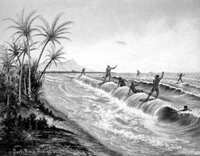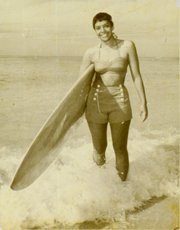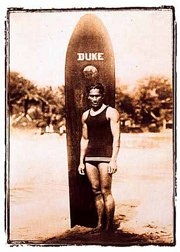|
History of Surfing
The history of surfing and the thrill of paddling into the waves with a surfboard began in the Pacific long before Europeans had explored the region. In 1778 Captain Cook landed in the Hawaiian islands and was the first westerner to document the sport that was such an integral part of Hawaiian culture and religion. At the time of his arrival the importance of surfing in the Hawaiian lifestyle was so significant that the kahuna would bless new surfboards with chants before they were taken out for the first time. Unfortunately, the arrival of more and more westerners caused a huge decline in surfing, apparently missionaries did not have much appreciation for people running around virtually naked and frolicking in the waves with surfboards. Especially the women. What for centuries had been the “Sport of Kings” (and queens) suffered a slowdown that reached low ebb about a century later. By the turn of the 20th century there were virtually empty beaches. Where once a queen had received bounteous gifts in retribution for the heinous crime of a commoner dropping in on her wave at Outside Castles, now people were covered from neck to foot in Victorian garb. Even if that story is apocryphal it says a lot. Some westerners actually had a great affinity for the sport and there are paintings and pictures of people surfing in Hawaii from these times, even some wood carvings. Good ol’ Samuel Clemens, aka Mark Twain even gave it a shot in 1866, but by his own words failed miserably and had a great time failing.
In a few isolated instances there were some Hawaiians that surfed in California in the 19th century, but the first publicized introduction was when tycoon Henry Huntington had George Freeth put on a surfing demonstration in 1907. The world renowned author Jack London had met Freeth surfing in Hawaii and immortalized him in the first literary descriptions glorifying surfing. Five years later Olympic swimmer Duke Kahanamoku really jump started the popularity of the sport. Between gold medal performances at the olympics in Australia he gave demonstrations of both swimming and surfing. Later trotting around the globe and showing everyone how much fun could be had in the water. Especially in bathing costumes a little less Victorian and a little more Hawaiian.

The sport had a huge spike in popularity up until WWII, with contests, drastically increasing numbers of surfers and the emergence of surf photography. After the war was over, surfing popularity skyrocketed, especially in California. Surf movies, surf music and the admiration of the surf lifestyle were embraced by the public. For the first time since Europeans made it a no-no for women to have as much fun surfing as men, the bravest women began to get off the beach blankets and into the water. Eve Fletcher, Marge Calhoun and Anona Napoleon all pioneered the sport and got the proverbial foot in the door for the explosion of popularity the sport has had among women, especially since the 80’s. Girls can have just as much fun as guys in the water, and a little competition never hurt anyone. Now surfing has spread from Hawaii to every continent in the world and every year the list of new wave discoveries grows. If the prerequisites for love of the sport: love of the outdoors, love of freedom, love of sun and love of the beach; are any indication then surfing will only continue to become more popular and the quest for the perfect wave will continue to be the siren call for millions. Return from History of Surfing to Surfing Girls Home page
|



 In 1905, Duke Kahanamoku and his friends created a surf club, Hui Nalu, or the club of the waves. Duke and his friends later became credited for bringing surfing back to Hawaii and became known as the beach boys of Waikiki. This was the beginning of the modern history of surfing.
In 1905, Duke Kahanamoku and his friends created a surf club, Hui Nalu, or the club of the waves. Duke and his friends later became credited for bringing surfing back to Hawaii and became known as the beach boys of Waikiki. This was the beginning of the modern history of surfing.